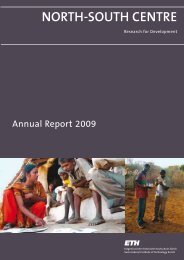Annual Report 2006/07 - ETH - North-South Centre North-South ...
Annual Report 2006/07 - ETH - North-South Centre North-South ...
Annual Report 2006/07 - ETH - North-South Centre North-South ...
Create successful ePaper yourself
Turn your PDF publications into a flip-book with our unique Google optimized e-Paper software.
Research Fellow Partnership Programme (RFPP)Research fellowGabriela Chacón, CIP, EcuadorSupervisorsCesare Gessler, IPW, <strong>ETH</strong> Zurich /Gregory Forbes, CIP, PeruCollaboratorMeridith Bonierbale, CIP, PeruDurationAugust 2001 – February 20<strong>07</strong>Variability in Phytophthora infestans and itspotential role in breeding for resistance in potatoLate blight, caused by Phytophthora infestans, is the maindisease of potato worldwide. Since the pathogen attacksother plant species in the Solanaceae family, a series of studieswere carried out on the pathogen population in Ecuadorto have a better understanding of its interaction with theseother solanaceous hosts. Isolates of Phytophthora infestanssensu lato (PISL) were collected from at least 20 host species,“Tomatillo”, a host of the section Anarrhichomenum, infected byPhytophthora infestans sensu lato.including the crops potato, tomato, pear melon, tree tomato,and naranjilla, and characterised with a set of phenotypicand genotypic markers. The results showed the existence offour pathogen groups. Three of these (EC-1, US-1, and EC-3)appeared to be clonal lineages, whereas a fourth group (EC-2),associated with hosts of the section Anarrhichomenum,included sexual forms. Isolates of both the EC-3 and the EC-2groups have genotypes distinct from all P. infestans genotypesdescribed in other parts of the world. This was confirmedwith the SSR characterisation, which showed the existenceof two major groups among PISL in Ecuador: one that correspondsto the “classical” P. infestans (EC-1 and US-1) and asecond group (EC-3 and EC-2), that corresponds toP. andina, a new species closely related to P. infestans.Although the different pathogen groups can infect morethan one host species, host specificity apparently plays amajor role in determining host range through quantitativedifferences in pathogen aggressiveness. Wild and cultivatedpotatoes are attacked by the same group (EC-1) and it seemsthat host specificity within this group does not exist. Thisimplies that potato breeders could use wild potatoes assources of resistance to late blight without worrying aboutthe eventual effects of widely diverse and host specificpathogen groups. Finally, the results showed a generalcorrelation between pathogen and host phylogenies, suggestinga process of co-evolution between solanaceoushosts and PISL in the tropical highlands of <strong>South</strong> America.44
















